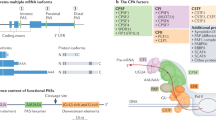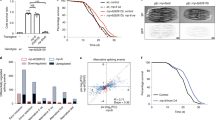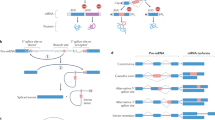Abstract
Circadian rhythms allow organisms to time biological processes to the most appropriate phases of the day–night cycle1. Post-transcriptional regulation is emerging as an important component of circadian networks2,3,4,5,6, but the molecular mechanisms linking the circadian clock to the control of RNA processing are largely unknown. Here we show that PROTEIN ARGININE METHYL TRANSFERASE 5 (PRMT5), which transfers methyl groups to arginine residues present in histones7 and Sm spliceosomal proteins8,9, links the circadian clock to the control of alternative splicing in plants. Mutations in PRMT5 impair several circadian rhythms in Arabidopsis thaliana and this phenotype is caused, at least in part, by a strong alteration in alternative splicing of the core-clock gene PSEUDO RESPONSE REGULATOR 9 (PRR9). Furthermore, genome-wide studies show that PRMT5 contributes to the regulation of many pre-messenger-RNA splicing events, probably by modulating 5′-splice-site recognition. PRMT5 expression shows daily and circadian oscillations, and this contributes to the mediation of the circadian regulation of expression and alternative splicing of a subset of genes. Circadian rhythms in locomotor activity are also disrupted in dart5-1, a mutant affected in the Drosophila melanogaster PRMT5 homologue, and this is associated with alterations in splicing of the core-clock gene period and several clock-associated genes. Our results demonstrate a key role for PRMT5 in the regulation of alternative splicing and indicate that the interplay between the circadian clock and the regulation of alternative splicing by PRMT5 constitutes a common mechanism that helps organisms to synchronize physiological processes with daily changes in environmental conditions.
This is a preview of subscription content, access via your institution
Access options
Subscribe to this journal
Receive 51 print issues and online access
$199.00 per year
only $3.90 per issue
Buy this article
- Purchase on Springer Link
- Instant access to full article PDF
Prices may be subject to local taxes which are calculated during checkout




Similar content being viewed by others
Accession codes
Primary accessions
Gene Expression Omnibus
Data deposits
The data discussed in this publication have been deposited in the National Center for Biotechnology Information Gene Expression Omnibus and are accessible through GEO Series accession number GSE18808 (http://www.ncbi.nlm.nih.gov/geo/query/acc.cgi?acc=GSE18808).
References
Young, M. W. & Kay, S. A. Time zones: a comparative genetics of circadian clocks. Nature Rev. Genet. 2, 702–715 (2001)
Hazen, S. et al. Exploring the transcriptional landscape of plant circadian rhythms using genome tiling arrays. Genome Biol. 10, R17 (2009)
Schoning, J. C., Streitner, C., Meyer, I. M., Gao, Y. & Staiger, D. Reciprocal regulation of glycine-rich RNA-binding proteins via an interlocked feedback loop coupling alternative splicing to nonsense-mediated decay in Arabidopsis. Nucleic Acids Res. 36, 6977–6987 (2008)
Guo, J., Cheng, P., Yuan, H. & Liu, Y. The exosome regulates circadian gene expression in a posttranscriptional negative feedback loop. Cell 138, 1236–1246 (2009)
Majercak, J., Chen, W. & Edery, I. Splicing of the period gene 3′-terminal intron is regulated by light, circadian clock factors, and phospholipase C. Mol. Cell. Biol. 24, 3359–3372 (2004)
Collins, B. H., Rosato, E. & Kyriacou, C. P. Seasonal behavior in Drosophila melanogaster requires the photoreceptors, the circadian clock, and phospholipase C. Proc. Natl Acad. Sci. USA 101, 1945–1950 (2004)
Bedford, M. & Richard, S. Arginine methylation: an emerging regulator of protein function. Mol. Cell 18, 263–272 (2005)
Gonsalvez, G., Rajendra, T., Tian, L. & Matera, A. The Sm-protein methyltransferase, Dart5, is essential for germ-cell specification and maintenance. Curr. Biol. 16, 1077–1089 (2006)
Anne, J., Ollo, R., Ephrussi, A. & Mechler, B. Arginine methyltransferase Capsuléen is essential for methylation of spliceosomal Sm proteins and germ cell formation in Drosophila. Development 134, 137–146 (2007)
Nozue, K. et al. Rhythmic growth explained by coincidence between internal and external cues. Nature 448, 358–361 (2007)
Alabadi, D. et al. Reciprocal regulation between TOC1 and LHY/CCA1 within the Arabidopsis circadian clock. Science 293, 880–883 (2001)
Pei, Y. et al. Mutations in the type II protein arginine methyltransferase AtPRMT5 result in pleiotropic developmental defects in Arabidopsis. Plant Physiol. 144, 1913–1923 (2007)
Schmitz, R., Sung, S. & Amasino, R. Histone arginine methylation is required for vernalization-induced epigenetic silencing of FLC in winter-annual Arabidopsis thaliana. Proc. Natl Acad. Sci. USA 105, 411–416 (2008)
Wang, X. et al. SKB1-mediated symmetric dimethylation of histone H4R3 controls flowering time in Arabidopsis. EMBO J. 26, 1934–1941 (2007)
Edwards, K. D. et al. FLOWERING LOCUS C mediates natural variation in the high-temperature response of the Arabidopsis circadian clock. Plant Cell 18, 639–650 (2006)
Farré, E. M., Harmer, S. L., Harmon, F. G., Yanovsky, M. J. & Kay, S. A. Overlapping and distinct roles of PRR7 and PRR9 in the Arabidopsis circadian clock. Curr. Biol. 15, 47–54 (2005)
Matsushika, A., Imamura, A., Yamashino, T. & Mizuno, T. Aberrant expression of the light-inducible and circadian-regulated APRR9 gene belonging to the circadian-associated APRR1/TOC1 quintet results in the phenotype of early flowering in Arabidopsis thaliana. Plant Cell Physiol. 43, 833–843 (2002)
Chari, A. et al. An assembly chaperone collaborates with the SMN complex to generate spliceosomal SnRNPs. Cell 135, 497–509 (2008)
Zhang, Z. et al. SMN deficiency causes tissue-specific perturbations in the repertoire of snRNAs and widespread defects in splicing. Cell 133, 585–600 (2008)
Gonsalvez, G. B., Praveen, K., Hicks, A. J., Tian, L. & Matera, A. G. Sm protein methylation is dispensable for snRNP assembly in Drosophila melanogaster. RNA 14, 878–887 (2008)
Simpson, C. G. et al. Monitoring changes in alternative precursor messenger RNA splicing in multiple gene transcripts. Plant J. 53, 1035–1048 (2008)
Raczynska, K. D. et al. Involvement of the nuclear cap-binding protein complex in alternative splicing in Arabidopsis thaliana. Nucleic Acids Res. 38, 265–278 (2010)
Zhang, N., Kallis, R. P., Ewy, R. G. & Portis, A. R. Light modulation of Rubisco in Arabidopsis requires a capacity for redox regulation of the larger Rubisco activase isoform. Proc. Natl Acad. Sci. USA 99, 3330–3334 (2002)
Sarov-Blat, L., So, W., Liu, L. & Rosbash, M. The Drosophila takeout gene is a novel molecular link between circadian rhythms and feeding behavior. Cell 101, 647–656 (2000)
Ceriani, M. F. et al. Genome-wide expression analysis in Drosophila reveals genes controlling circadian behavior. J. Neurosci. 22, 9305–9319 (2002)
Glaser, F. T. & Stanewsky, R. Temperature synchronization of the Drosophila circadian clock. Curr. Biol. 15, 1352–1363 (2005)
Zhang, D., Abovich, N. & Rosbash, M. A biochemical function for the Sm complex. Mol. Cell 7, 319–329 (2001)
Schor, I. E., Rascovan, N., Pelisch, F., Alló, M. & Kornblihtt, A. R. Neuronal cell depolarization induces intragenic chromatin modifications affecting NCAM alternative splicing. Proc. Natl Acad. Sci. USA 106, 4325–4330 (2009)
McDonald, M. & Rosbash, M. Microarray analysis and organization of circadian gene expression in Drosophila. Cell 107, 567–578 (2001)
Rosbash, M. The implications of multiple circadian clock origins. PLoS Biol. 7, e62 (2009)
Alonso, J. M. et al. Genome-wide insertional mutagenesis of Arabidopsis thaliana. Science 301, 653–657 (2003)
Murashige, T. & Skoog, F. A revised medium for rapid growth and bioassays with tobacco tissue cultures. Physiol. Plant. 15, 473–497 (1962)
Rezával, C., Werbajh, S. & Ceriani, M. F. Neuronal death in Drosophila triggered by GAL4 accumulation. Eur. J. Neurosci. 25, 683–694 (2007)
Hicks, K. A. et al. Conditional circadian dysfunction of the Arabidopsis early-flowering 3 mutant. Science 274, 790–792 (1996)
Plautz, J. D. et al. Quantitative analysis of Drosophila period gene transcription in living animals. J. Biol. Rhythms 12, 204–217 (1997)
Millar, A. J., Carre, I. A., Strayer, C. A., Chua, N. H. & Kay, S. A. Circadian clock mutants in Arabidopsis identified by luciferase imaging. Science 267, 1161–1163 (1995)
Strayer, C. et al. Cloning of the Arabidopsis clock gene TOC1, an autoregulatory response regulator homolog. Science 289, 768–771 (2000)
Michael, T. P. et al. A morning-specific phytohormone gene expression program underlying rhythmic plant growth. PLoS Biol. 6, e225 (2008)
Tusher, V. G., Tibshirani, R. & Chu, G. Significance analysis of microarrays applied to the ionizing radiation response. Proc. Natl Acad. Sci. USA 98, 5116–5121 (2001)
Zhang, X., Byrnes, J., Gal, T., Li, W.-H. & Borevitz, J. Whole genome transcriptome polymorphisms in Arabidopsis thaliana. Genome Biol. 9, R165 (2008)
Sheth, N. et al. Comprehensive splice-site analysis using comparative genomics. Nucleic Acids Res. 34, 3955–3967 (2006)
Crooks, G. E., Hon, G., Chandonia, J.-M. & Brenner, S. E. WebLogo: a sequence logo generator. Genome Res. 14, 1188–1190 (2004)
Perales, M. & Mas, P. A functional link between rhythmic changes in chromatin structure and the Arabidopsis biological clock. Plant Cell 19, 2111–2123 (2007)
Métivier, R. et al. Estrogen receptor-α directs ordered, cyclical, and combinatorial recruitment of cofactors on a natural target promoter. Cell 115, 751–763 (2003)
Bastow, R. et al. Vernalization requires epigenetic silencing of FLC by histone methylation. Nature 427, 164–167 (2004)
Acknowledgements
We thank E. M. Farré and S. L. Harmer for seeds; J. J. Casal and S. Mora-García for critical reading of the manuscript; the laboratories of A.R.K. and M.J.Y. for discussions; J. Fuller and P. Tondi for technical assistance. This work was supported by grants from the Fundación Antorchas, the Agencia Nacional de Promoción de Ciencia y Tecnología of Argentina, the Consejo Nacional de Investigaciones Científicas y Técnicas of Argentina and the University of Buenos Aires to M.J.Y. and A.R.K., and from the European Union Network of Excellence on Alternative Splicing (EURASNET) to A.R.K. and J.W.S.B. M.J.Y. and A.R.K. are Howard Hughes Medical Institute international research scholars. P.M.’s laboratory is supported by a Ministerio de Educación y Ciencia grant, the European Young Investigator Awards and the EMBO Young Investigator Awards; M.F.C.’s laboratory is supported by Proyecto de Investigación Científica y Tecnológica 2006-1249.
Author information
Authors and Affiliations
Contributions
S.E.S. and E.P. contributed equally to this work and performed most of the experiments in this study, with technical assistance from M.L.R., C.E.H., M.A.G.H. and P.D.C. J.C.C. and P.M. conducted bioluminescence and chromatin immunoprecipation assays. E.J.B. and A.D.C. performed locomotor activity assays, RNA extractions and immunostaining experiments in Drosophila. E.P., C.G.S. and J.W.S.B. performed high-resolution RT–PCR experiments. X.Z. and J.O.B. analysed tiling array data. S.E.S., E.P., M.F.C., A.R.K. and M.J.Y. provided input in the preparation of the manuscript, and S.E.S., E.P. and M.J.Y. wrote the paper.
Corresponding author
Ethics declarations
Competing interests
The authors declare no competing financial interests.
Supplementary information
Supplementary Figures
This file contains Supplementary Figures 1-23 with legends. (PDF 582 kb)
Supplementary Tables
This file contains Supplementary Tables 1-10. (XLS 589 kb)
Rights and permissions
About this article
Cite this article
Sanchez, S., Petrillo, E., Beckwith, E. et al. A methyl transferase links the circadian clock to the regulation of alternative splicing. Nature 468, 112–116 (2010). https://doi.org/10.1038/nature09470
Received:
Accepted:
Published:
Issue Date:
DOI: https://doi.org/10.1038/nature09470
This article is cited by
-
Regulation of micro- and small-exon retention and other splicing processes by GRP20 for flower development
Nature Plants (2024)
-
The physiology of alternative splicing
Nature Reviews Molecular Cell Biology (2023)
-
A type II protein arginine methyltransferase regulates merozoite invasion in Plasmodium falciparum
Communications Biology (2023)
-
Variations in Circadian Clock Organization & Function: A Journey from Ancient to Recent
Planta (2022)
-
The circadian clock ticks in plant stress responses
Stress Biology (2022)
Comments
By submitting a comment you agree to abide by our Terms and Community Guidelines. If you find something abusive or that does not comply with our terms or guidelines please flag it as inappropriate.



